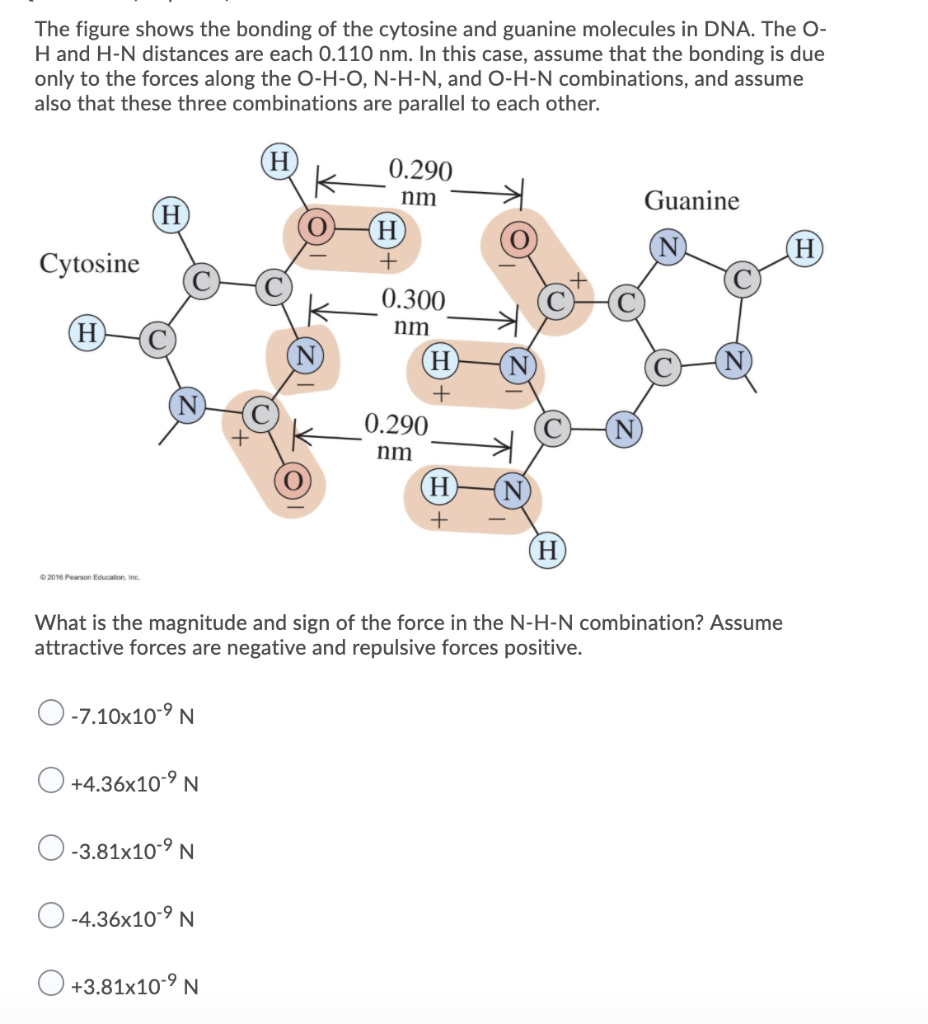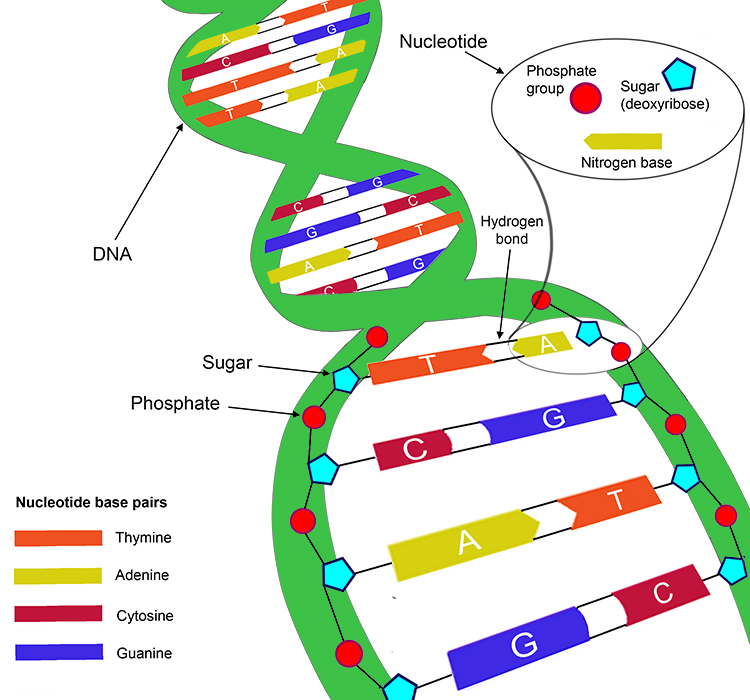Cytosine And Guanine Form Three Hydrogen Bonds Between One Another
Cytosine And Guanine Form Three Hydrogen Bonds Between One Another - Two base pairs are produced by four nucleotide monomers, nucleobases are in blue. Web guanine pairs with cytosine with 3 hydrogen bonds [6].this creates a difference in strength between the two sets of watson and crick bases. Web you see, cytosine can form three hydrogen bonds with guanine, and adenine can form two hydrogen bonds with thymine. Cytosine and guanine form three hydrogen bonds between one another. Web the base pairing in dna between molecules of guanine and cytosine is shown in the given structure. Web the number of hydrogen bonds between guanine and cytosine; Or, more simply, c bonds with g. Adenine pairs with thymine, and cytosine pairs with guanine. Web guanine bonds to cytosine because they both share three hydrogen bonds. Guanine (g) is one of the four nucleotide bases in dna, with the other three being adenine (a), cytosine (c) and thymine (t).
Density functional theory is used to study the hydrogen bonding pattern in cytosine, which does not contain alternating proton donor and acceptor sites. Web in dna, adenine (a) and thymine (t) are complementary base pairs, and cytosine (c) and guanine (g) are also complementary base pairs, explaining chargaff’s rules. You'll get a detailed solution from a subject. A nitrogenous base is part of the structure of the dna molecule. Two base pairs are produced by four nucleotide monomers, nucleobases are in blue. L), formed by monomers in nonaqueous. Cytosine and guanine form three hydrogen bonds between one another. Web cytosine and guanine form three hydrogen bonds between one another are the true statement. Web the two strands are held together by hydrogen bonds between pairs of bases: And between adenine and thymine in dna are:
True false this problem has been solved! L), formed by monomers in nonaqueous. Web cytosine and guanine form three hydrogen bonds between one another. Web guanine bonds to cytosine because they both share three hydrogen bonds. And between adenine and thymine in dna are: Web the number of hydrogen bonds between guanine and cytosine; 1 mixtures can form a planar dimer stabilized by three hydrogen bonds. How many hydrogen bonds can be formed between molecules of. Web in dna, adenine (a) and thymine (t) are complementary base pairs, and cytosine (c) and guanine (g) are also complementary base pairs, explaining chargaff’s rules. Web that monomeric guanine and cytosine in 1 :
Solved Cytosine and guanine form three hydrogen bonds
Qualitatively, guanine (g) and cytosine (c) undergo a specific hydrogen bonding with each other, whereas adenine (a) bonds specifically with thymine (t) in dna and. Or, more simply, c bonds with g. 1 mixtures can form a planar dimer stabilized by three hydrogen bonds. Web cytosine and guanine form three hydrogen bonds between one another are the true statement. Guanine.
Solved Cytosine and guanine form three hydrogen bonds
Web the number of hydrogen bonds between guanine and cytosine; Cytosine and guanine form three hydrogen bonds between one another. True false true/false this problem has been solved! Web properties guanine, along with adenine and cytosine, is present in both dna and rna, whereas thymine is usually seen only in dna, and uracil only in rna. Qualitatively, guanine (g) and.
The number of hydrogen bonds between cytosine (C) and guanine (G) is
Adenine pairs with thymine, and cytosine pairs with guanine. Or, more simply, c bonds with g. Web the two strands are held together by hydrogen bonds between pairs of bases: When a nucleotide in one chain of dna or rna has guanine as its base, the. Web in dna, adenine (a) and thymine (t) are complementary base pairs, and cytosine.
Hydrogen bonds in nucleotides cytosine and guanine
Web hydrogen bond between guanine and cytosine | guanine cytosine base pair | nitrogenous base pairing nitrogenous base pairing in dna, in dna double helix structure. Two base pairs are produced by four nucleotide monomers, nucleobases are in blue. Or, more simply, c bonds with g. Guanine (g) is one of the four nucleotide bases in dna, with the other.
Deoxyribonucleic Acid The Definitive Guide Biology Dictionary
L), formed by monomers in nonaqueous. And between adenine and thymine in dna are: True false true/false this problem has been solved! Or, more simply, c bonds with g. A nitrogenous base is part of the structure of the dna molecule.
DNA. Structure and Replication Presentation Biology
Two base pairs are produced by four nucleotide monomers, nucleobases are in blue. L), formed by monomers in nonaqueous. Web guanine pairs with cytosine with 3 hydrogen bonds [6].this creates a difference in strength between the two sets of watson and crick bases. Qualitatively, guanine (g) and cytosine (c) undergo a specific hydrogen bonding with each other, whereas adenine (a).
Solved Cytosine and guanine form three hydrogen bonds
Guanine (g) is one of the four nucleotide bases in dna, with the other three being adenine (a), cytosine (c) and thymine (t). Web in dna, adenine (a) and thymine (t) are complementary base pairs, and cytosine (c) and guanine (g) are also complementary base pairs, explaining chargaff’s rules. Web guanine pairs with cytosine with 3 hydrogen bonds [6].this creates.
4 Base pairs in DNA. Panel (a) shows the guaninecytosine (GC) hydrogen
Two base pairs are produced by four nucleotide monomers, nucleobases are in blue. Cytosine and guanine form three hydrogen bonds between one another. 1 mixtures can form a planar dimer stabilized by three hydrogen bonds. You'll get a detailed solution from a subject. Qualitatively, guanine (g) and cytosine (c) undergo a specific hydrogen bonding with each other, whereas adenine (a).
Solved The figure shows the bonding of the cytosine and
Web guanine pairs with cytosine with 3 hydrogen bonds [6].this creates a difference in strength between the two sets of watson and crick bases. Cytosine and guanine form three hydrogen bonds between one another. You'll get a detailed solution from a subject. And between adenine and thymine in dna are: Web properties guanine, along with adenine and cytosine, is present.
Which Pair Of Nitrogenous Bases Will Form A Bond In A Dna Molecule
You'll get a detailed solution from a subject. When a nucleotide in one chain of dna or rna has guanine as its base, the. Or, more simply, c bonds with g. Web cytosine and guanine form three hydrogen bonds between one another are the true statement. Adenine pairs with thymine, and cytosine pairs with guanine.
Qualitatively, Guanine (G) And Cytosine (C) Undergo A Specific Hydrogen Bonding With Each Other, Whereas Adenine (A) Bonds Specifically With Thymine (T) In Dna And.
Web the base pairing in dna between molecules of guanine and cytosine is shown in the given structure. When a nucleotide in one chain of dna or rna has guanine as its base, the. You'll get a detailed solution from a subject. True false true/false this problem has been solved!
Guanine (G) Is Paired With Cytosine (C) Via Three Hydrogen.
Two base pairs are produced by four nucleotide monomers, nucleobases are in blue. Web properties guanine, along with adenine and cytosine, is present in both dna and rna, whereas thymine is usually seen only in dna, and uracil only in rna. Or, more simply, c bonds with g. Web you see, cytosine can form three hydrogen bonds with guanine, and adenine can form two hydrogen bonds with thymine.
Adenine Pairs With Thymine, And Cytosine Pairs With Guanine.
How many hydrogen bonds can be formed between molecules of. True false this problem has been solved! Web cytosine and guanine form three hydrogen bonds between one another are the true statement. Cytosine and guanine form three hydrogen bonds between one another.
Web Hydrogen Bond Between Guanine And Cytosine | Guanine Cytosine Base Pair | Nitrogenous Base Pairing Nitrogenous Base Pairing In Dna, In Dna Double Helix Structure.
Web the two strands are held together by hydrogen bonds between pairs of bases: 1 mixtures can form a planar dimer stabilized by three hydrogen bonds. Web guanine bonds to cytosine because they both share three hydrogen bonds. Web guanine pairs with cytosine with 3 hydrogen bonds [6].this creates a difference in strength between the two sets of watson and crick bases.





.PNG)



